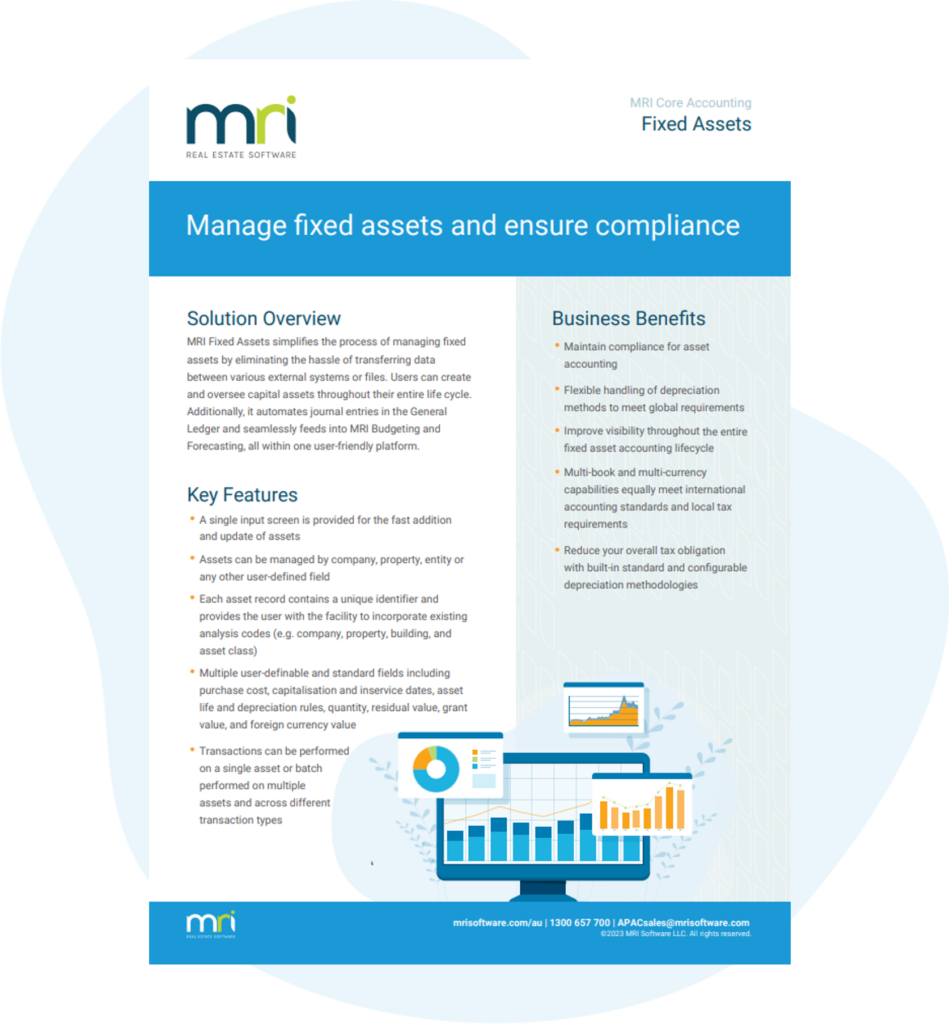Seven sins of spreadsheets for controlling fixed assets
Some real estate organisations and property management firms still use spreadsheets to manage fixed assets. Manual fixed asset management methods are labor intensive, prone to errors, make compliance difficult, and add considerably to the total cost of asset ownership through heightened insurance premiums and property taxes, as well as neglected depreciation.
Why should an organisation trade in its spreadsheets for a dedicated fixed asset management system?
A good fixed asset management system moves away from spreadsheets and consolidates asset information in a centralised asset register which can be accessed by multiple departments—finance, IT, maintenance. A system that incorporates asset tracking software will speed up physical audits, making it easier to build and maintain an accurate fixed asset register. With a purpose-built system in place, producing accurate depreciation and amortisation calculations and maintaining compliance is easily achieved.
There are many compelling reasons why spreadsheets are not a reliable method for managing fixed assets in the real estate industry, and below are the top seven.
1. Inaccurate depreciation calculations
Whether due to incorrect background asset data or a wrong formula, most spreadsheets contain errors. This is to be expected when effective controls are absent and multiple parties are contributing data. As a result, depreciation calculations done using a spreadsheet are likely to be inaccurate. A specialist fixed asset management system will eliminate costly depreciation errors by enabling depreciation formulas and asset lives to be defaulted for each book based on any defined asset category within the system. Processing depreciation this way is quick and easy, and can be completed with just the click of a button!
2. Lack of an audit trail and overall security
Fixed asset management software tracks and records every detail of each user’s activities. Dates, times, and explanations are recorded, ensuring the security of asset data. A secure system will require a valid username and password combination to enter the system and will allow department heads to define security at an individual user level so that access to confidential information can be restricted. This cannot be accomplished using spreadsheets.
3. Corporate governance requirements
The corporate scandals of the early 2000s opened up the financial reporting standards of publicly-traded companies to further scrutiny. As a result, Sarbanes Oxley—which addresses financial reporting standards and the integrity of systems used to produce those reports—was signed into law in 2002 in an effort to curtail off-sheet accounting. Companies across the board are tightening control over their fixed assets in an effort to improve financial management, reporting, and corporate governance; unreliable spreadsheets are not part of that plan! Accurate and effective fixed asset management software is the most efficient way to ensure compliance with U.S. and international accounting standards.
4. Inability to link ‘parent/ child’ assets or conduct asset splits, batch disposals, etc
The ability to link ‘parent/child’ assets is essential to establishing hierarchical
relationships and dependencies. A specialist fixed asset management system displays such links pictorially in collapsible branches. A typical example of this might be the association between a building’s security
system and its related security cameras, where the system is the ‘parent’ and the camera assumes the role of the ‘child’. The option to transfer or dispose of the ‘child’ asset will subsequently follow the transfer or disposal of the ‘parent’ asset, keeping the relationship intact.
Spreadsheets are unable to accommodate ‘parent/child’ asset relationships in this way, making it difficult to accurately track and manage these important hierarchical dependencies. Their inability to conduct automated asset splits and batch disposals also cause similar problems.
5. Access to multi- currency, multi-lingual or multi-book capabilities
Companies that operate in more than one country may need multi-currency, multi-lingual, and multi-book capabilities from their fixed asset system. Multi-book capabilities allow core asset information to be shared across any number of books with different sets of figures, enabling compliance with both local and group depreciation policies. Vital information such as analysis codes, descriptions, purchase costs, acquisition, and capitalisation dates, etc. can remain constant across all books, while details such as asset life, depreciation rules, and residual values can be book dependent.
Fixed asset software with multi-book capabilities will allow each accounting book to be independently configured to meet international accounting standards. Within the asset register, each office location should be able to record and report on its own assets
in local currency. User-defined exchange rates will allow the parent company to easily view and report on the same values in the company’s base currency.
6. Unable to meet historical reporting and forecasting requirements
Composing reports and forecasts can be a complicated and daunting process, especially if attempted in a spreadsheet. The data produced is far too important to risk inaccuracies. A fixed asset management system will incorporate standard and configurable reporting and forecasting templates to ensure an intuitive method of extracting and analysing asset data.
7. Time-consuming manual process & poor data integrity
Whether it is a user input error or unintentional miscalculation, inaccuracies within the
fixed asset register are inevitable when using a spreadsheet system. Fixed asset software will have strict validation features in place to effortlessly address such issues.
Additionally, entering and maintaining asset data becomes an endless task when working within the parameters of a spreadsheet, while a software system automates the entire fixed asset management process. From data- import capabilities to automated reports and forecasts, a significant amount of valuable time can be saved by automating certain steps and minimising errors.
Recommendations and Added Benefits
The spreadsheet is an integral part of business operations but cannot perform all tasks, especially when it comes to managing fixed assets effectively. While the importance of tracking and monitoring assets is often overlooked in real estate organisations, the new lease accounting standards that go into effect soon will require compliance from all businesses.
Fixed Asset Management software
Have confidence in the accuracy of your asset register and get the data you need at the touch of a button.

As a part of a broader fiscal strategy, the move to more accurate and effective asset management can be invigorating to real estate and property management businesses, providing essential
short-term cash flow benefits as well as positive longer-term advantages. Many businesses are able to lower their insurance premiums and achieve more successful insurance claims, as well as decreased property taxes. These result from having an accurate record of assets that may no longer be on the books. Automated fixed asset management systems are integral to responsible
financial management and compliance, providing more accurate financial statements, tax benefits, streamlined workflow processes, and sound business continuity plans.
Quickly get the data you need with MRI’s comprehensive Fixed Asset Management software.
Streamline Fixed Asset Management and Maintain Compliance
Experience the simplicity of overseeing your fixed assets with MRI Fixed Asset Accounting. Our intuitive platform reduces data transfer complexities across systems, ensuring smooth asset management for their entire lifecycle. Enhance your MRI platfor…

